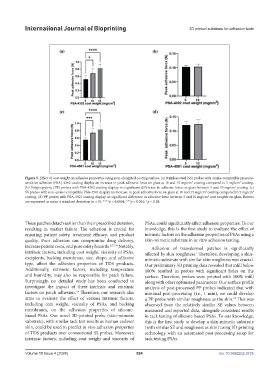Page 532 - IJB-10-4
P. 532
International Journal of Bioprinting 3D printed substrate for adhesion tests
Figure 5. Effect of coat weight on adhesive properties using non-elongated coating surface. (a) Stainless steel (SS) probes with amine-compatible pressure-
sensitive adhesive (PSA)-4302 coating display an increase in peak adhesive force on glass at 10 and 15 mg/cm coating compared to 5 mg/cm coating.
2
2
(b) Polypropylene (PP) probes with PSA-4302 coating display no significant difference in adhesive force on glass between 5 and 10 mg/cm coating. (c)
2
SS probes with non-amine-compatible PSA-4501 display an increase in peak adhesive force on glass at 10 and 15 mg/cm coating compared to 5 mg/cm
2
2
coating. (d) PP probes with PSA-4501 coating display no significant difference in adhesive force between 5 and 10 mg/cm coat weights on glass. Results
2
are expressed as mean ± standard deviation (n = 5). ****p < 0.0001; ***p < 0.001; *p < 0.05.
These patches detach earlier than their prescribed duration, PSAs, could significantly affect adhesion properties. To our
resulting in market failure. The adhesion is crucial for knowledge, this is the first study to evaluate the effect of
ensuring patient safety, treatment efficacy, and product intrinsic factors on the adhesion properties of PSAs using a
quality. Poor adhesion can compromise drug delivery, skin-mimetic substrate in in vitro adhesion testing.
increase patient costs, and pose safety hazards. 4,37,38 Notably, Adhesion of transdermal patches is significantly
intrinsic factors, including coat weight, viscosity of PSAs, affected by skin roughness. Therefore, developing a skin-
1
excipients, backing membrane, size, shape, and adhesive mimetic substrate with similar skin roughness was crucial.
type, affect the adhesion properties of TDS products. Our preliminary 3D printing data revealed that infill below
Additionally, extrinsic factors, including temperature 100% resulted in probes with significant holes on the
and humidity, may also be responsible for patch failure. surface. Therefore, probes were printed with 100% infill
Surprisingly, no detailed study has been conducted to along with other optimized parameters. Our surface profile
investigate the impact of these intrinsic and extrinsic analysis of post-processed PP probes indicated that with
factors on patch adhesion. Therefore, our research also minimal post-processing (i.e., 1 min), we could develop
1,4
aims to evaluate the effect of various intrinsic factors, a PP probe with similar roughness as the skin. This was
28
including coat weight, viscosity of PSAs, and backing observed from the relatively similar SE values between
membranes, on the adhesion properties of silicone- measured and reported data, alongside consistent results
based PSAs. Our novel 3D-printed probe (skin-mimetic in tack testing of silicone-based PSAs. To our knowledge,
substrate), with similar tack test results as human cadaver this is the first study to develop a skin-mimetic substrate
skin, could be used to predict in vivo adhesion properties (with similar SE and roughness as skin) using 3D printing
of TDS products over conventional SS probes. Moreover, technology with an automated post-processing setup for
intrinsic factors, including coat weight and viscosity of tack testing PSAs.
Volume 10 Issue 4 (2024) 524 doi: 10.36922/ijb.3735

